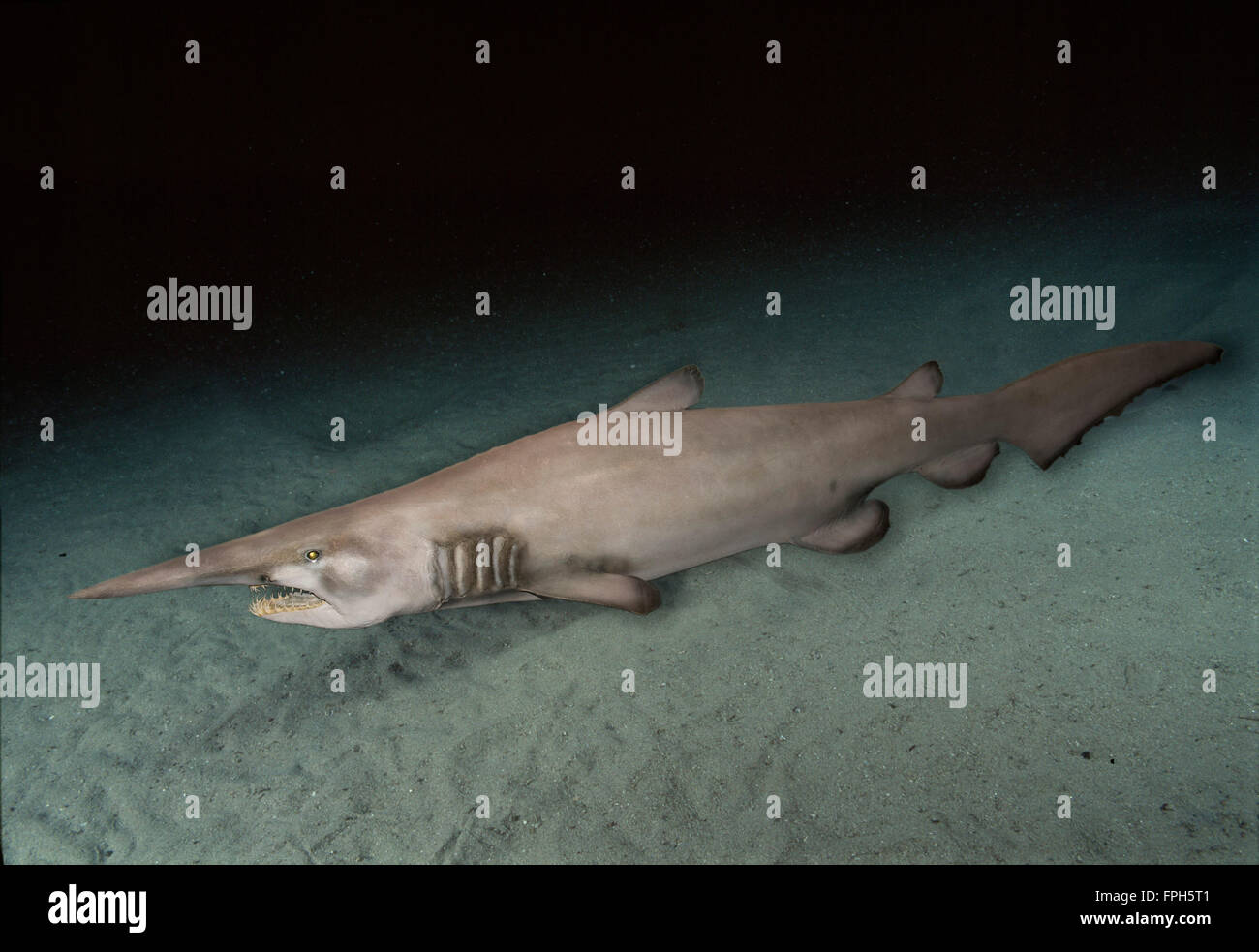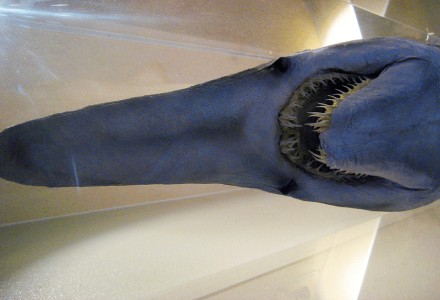

The proportional length of the snout decreases with age. The goblin shark has a distinctively long and flat snout, resembling a blade. Description The goblin shark's jaws extend dramatically when feeding. As the last member of an ancient lineage, and one that retains several " primitive" traits, the goblin shark has been described as a " living fossil". 66–23 Ma), may also be a Mitsukurina species. Striatolamia macrota, which lived in warm shallow waters during the Paleogene period ( c. Mitsukurina itself first appears in the fossil record during the period Middle Eocene ( c. The family Mitsukurinidae, represented by Mitsukurina, Scapanorhynchus, and Anomotodon, dates back to the Aptian age of the Cretaceous period ( c. Studies using genetic data have also confirmed a basal classification for this species.

Phylogenetic studies based on morphology have classified the goblin shark as the most basal member of the order Lamniformes, known as mackerel sharks. This taxonomic confusion began because the specimens' jaws were fixed at varying degrees of protrusion during preservation, giving the appearance of proportional differences among the heads. Several goblin shark specimens were described as separate species from 1904 to 1937, none of which are now considered valid. Eventually, more complete fossils revealed many anatomical differences between Scapanorhynchus and Mitsukurina, causing modern authors to again regard them as distinct genera. For a time, the prevailing opinion was to treat Mitsukurina as a junior synonym of Scapanorhynchus. Soon after Jordan's description was published, several scientists noted the similarity between Mitsukurina and the extinct Mesozoic shark Scapanorhynchus. Another name for this species is elfin shark. The common name "goblin shark" is a calque of its traditional Japanese name tenguzame, a tengu being a Japanese mythical creature often depicted with a long nose and red face. Jordan named the shark Mitsukurina owstoni in honor of these two men. The specimen had been acquired by shipmaster and naturalist Alan Owston, who had given it to Professor Kakichi Mitsukuri at the University of Tokyo, who in turn brought it to Jordan. He based his account on an immature male 107 cm (42 in) caught in Sagami Bay near Yokohama, Japan. Taxonomy Differing jaw positions in preserved goblin sharks caused several specimens to be described erroneously as distinct species.Īmerican ichthyologist David Starr Jordan described the goblin shark in an 1898 issue of Proceedings of the California Academy of Sciences, recognizing the peculiar fish not only as a new species, but also a new genus and family. The International Union for Conservation of Nature (IUCN) has assessed it as Least Concern, despite its rarity, citing its wide distribution and low incidence of capture.

Small numbers of goblin sharks are unintentionally caught by deepwater fisheries.

Its long snout is covered with ampullae of Lorenzini that enable it to sense minute electric fields produced by nearby prey, which it can snatch up by rapidly extending its jaws. This species hunts for teleost fishes, cephalopods, and crustaceans both near the sea floor and in the middle of the water column. Various anatomical features of the goblin shark, such as its flabby body and small fins, suggest that it is sluggish in nature. Some researchers believe that these sharks could also dive to depths of up to 1,300 m (4,270 ft), for short periods of time. Goblin sharks are benthopelagic creatures that inhabit upper continental slopes, submarine canyons, and seamounts throughout the world at depths greater than 100 m (330 ft), with adults found deeper than juveniles. It is usually between 3 and 4 m (10 and 13 ft) long when mature, though it can grow considerably larger such as one captured in 2000 that is thought to have measured 6 m (20 ft). This pink-skinned animal has a distinctive profile with an elongated, flat snout, and highly protrusible jaws containing prominent nail-like teeth. Sometimes called a " living fossil", it is the only extant representative of the family Mitsukurinidae, a lineage some 125 million years old. The goblin shark ( Mitsukurina owstoni) is a rare species of deep-sea shark. Scapanorhynchus dofleini Engelhardt, 1912.


 0 kommentar(er)
0 kommentar(er)
